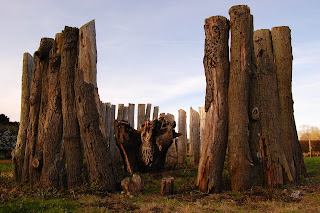
Seahenge is a Bronze age (contemporary to doll tor, main lifespan of stonehenge) monument, discovered at Holme in 1998, although local residents have suggested that various other seahenges appeared and dissapeared regularly along the shifting sands of the coast for many years prior to this. Francis Pryor thought that its place on the coast, situated in the Fens gave it a spiritual significance of bridging the gaps between the living world and the afterlife. Looking at the smashan burning grounds on the banks of the Ganges its easy to draw similarities between the two funereal practices, the reversal of the menstrual tide as the body and blood decay and are absorbed back into the Rainbow Serpent flowing of the seas and the rivers. Excarnation occurs, the bones are broken and the soul can be freed. Aubrey Burl theorizes in Rites of the Gods that the breaking of cremated bones, an act which appears to have been common throughout the UK's neolithic burial sites, was seen to free the soul, although skulls and jaw bones were often kept as totems for ritual use, or placed in mortuary houses to preserve the power of a communitys ancestors. Trephination similarly can be seen as a way to release the demons/spirits causing pain in the head, and the breaking of the bone releases the pressure and the demon. Evidence of trepanning goes back 40,000 years in human civilisation, an example from the Thames, near Hammersmith shows a hole in the head, seemingly deliberate in shape and with five years worth of regrowth of bone. The skull is between 3 and 5 thousand years old, a similar time frame to stonehenge and seahenge. The use of trepanning as a migraine relief mechanism makes sense to the sufferer, a release of pressure.
The migraine trance I have found myself in often leads to an internal exploration of the ability to transcend physical boundaries, in the many hours spent lying alone in bed, unable to sleep or move because of the pain you need to become adjusted to the sensation, otherwise it can be hard to keep a hold of your self. In disconnecting with the pain through trancework I have found it possible to find within it useful techniques and easier ways to achieve that state of mind. Entoptic visions are a nuisance in a public situation, but within a controlled state can bring one closer to visionary experiences. The visuals could be likened to descriptions of psychoactive drugs, geometric shapes and colours, flashes lights and strange auras. I've been told on several occasions that when ill, I lie with my eyes open but unconscious of whats going on around me, I contemplate nothing, pain becomes a distant echo. It sounds like a melodramatic statement, but many times I have felt rising panic at the situation, the unbearable pain and pressure feels like it must give way to some catastrophic internal event and death will soon follow. Cluster headaches have often sent me falling to the ground, seized by some terrible force that seems certain to kill me, or drive me to kill myself with the crushing agony of it. The connection between migraines and death, the trance-like existance of the migraine sufferer seems obvious to me, it binds you to follow a cycle of rebirth, feeling estatic at the pureness of becoming pain-free again, giddy and alive after days of isolation, darkness and complete introversion. The migraine dream, where the onset occurs before you wake, are always of death, and dying. The pain crushes you and you feel the slow inevitability of dying, or being dead and knowing no end to the paralysed pain. Through controlling your breathing, the pain does not nessesarily go away, but you move away from it. The state of mind you have control over does not need to correspond directly to the physical complaints of your body. The only unfortunate effect of becoming disconnected from the pain is that you no longer struggle to keep the pain under control, I have gone whole days without drinking or attempting to eat, or take painkillers which ultimately will prolong the migraine. The life of a migraine sufferer is often interspersed with these long contemplative times when they can do little else but think of their pain, I think it helps to try and use it productively if possible.
Seahenge is now preserved in wax and on display at Kings Lynn museum.
this is 'Applehenge', the replica constructed for the Time Team programme on the excavation of Seahenge. There was some controversy surrounding this structure, due to the fact no planning permission was obtained for it to be built, and the Oak used for the centre was a protected tree. Its location in an orchard in Norfolk is now unadvertised and very low-key, presumably due to these problems.
Despite the issues with Applehenge, I couldn't help but feel the value of reconstructing the monument in full size. The aging of the timbers since the programme was aired, with Ivy curling up the centre tree, gave it a somber air of beauty. It is very easy to imagine the place bedecked with funereal adornments, lone yggdrasil in the marshes with a rain-washed figure prostrate on the upturned roots.






















g!Wk~%24(KGrHgoOKjUEjlLmTEG6BKpzcn6wsw~~_35.jpg)